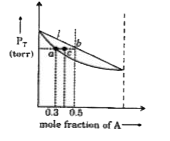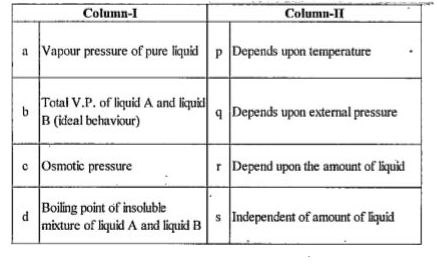Assertion : If a liquid solute more volatile than the solvent is added to the solvent, the papour pressure of the solution may increase i.e. ps>p∘.
Reason In the presence of a more volatile liquid solute, only the solute will form the vapours and solvent will not.Solution in Malayalam
Statement 1 is True, Statement 2 is true, Statement 2 is correct explanation for Statement 1
Statement 1 is True, Statement 2 is True, Statement 2 is NOT a correct explanation for Statement 1
Statement 1 is True, Statement 2 is False
Statement 1 is False, Statement 2 is True
The correct Answer is:C
Both the solute and solvent will form the vapours but vapour phase will become richer in the more volatile component.
Topper's Solved these Questions
- BOOK - BRILLIANT PUBLICATIONCHAPTER - SOLUTIONSEXERCISE - Level-III (Linked Comprehension Type)12videos
SOLUTIONS
- BOOK - BRILLIANT PUBLICATIONCHAPTER - SOLUTIONSEXERCISE - Level-III (Matching Column Type)5videos
SOLUTIONS
- BOOK - BRILLIANT PUBLICATIONCHAPTER - SOLID STATEEXERCISE - LEVEL-3 (Linked Comprehension Type)10videos
SOLID STATE
- BOOK - BRILLIANT PUBLICATIONCHAPTER - STEREOCHEMISTRY EXERCISE - LEVEL-II (ASSERTION - REASON TYPE)2videos
STEREOCHEMISTRY
Similar Questions
1 mole of A and 1 mole B are mixed together to form an ideal solution at 25∘C. Solution is placed in a vessel fitted with piston. If pressure on the solution is reduced isothermally.

Correct relationship between P∘AandP∘B is01:28View SolutionMatch the columns
 02:50View Solution
02:50View SolutionF centre is an example of metal excess defect due to the presence of extra cations at interstitial sites. Zinc oxide is white in colour at room temperature, on heating it loses oxygen and turns yellow.
ZnOHeat−−→Zn2++12O2+2e−
Now there is excess of zinc in the crystal and its formula becomes Zn1+x O. the excess of Zn2+ ions move to interstitial sites and the electrons to neighbouring interstitial sites.
There are many solids which are difficult to prepare in the stiochiometric composition and contain less amount of the metal as compared to stiochiometric proportion. a typical example of this type is FeO which is mostly found with a composition of Fe0.95. it may actually range from Fe0.96 O.
Q. In Fe0.95 O:View SolutionAssertion : Meso tartaric acid is optically inactive
Reason : Meso tartaric acid has a plane of symmetry01:33View SolutionIf P∘ the vapour pressure of a pure solvent and P is the vapour pressure of the solution prepared by dissolving a non volatile solute in it. The mole fraction of the solvent XA is given by:
View SolutionHow is relative lowering of vapour pressure defined for a solution consisting of volatile solvent and non-volatile solute ? How is this function related to the mole fraction of the solvent and of the solute?
04:21View SolutionWhy is vapour pressure of solvent lowered on adding non-volatile solute to it ?
01:58View SolutionAssertion :- If a liquid solute more volatile than the solvent is added to the solvent, the vapour pressure of the solution may increase i.e., ps>p∘.
Reason :- In the presence of a more volatile liquid solute, only the solute will form vapours and solvent will not.01:33View SolutionAssertion : Vapour pressure of solvent increases when solvent B is added.
Reason : B is more volatile therefor vapour pressure of B is greater than of A.01:33View SolutionThe vapour pressure of a solution containing non volatile solute is less than the vapour pressure of pure of solvent. Give reason.
02:37View SolutionThe vapour pressure (VP) of a dilute solution of non-volatile solute is P and the VP of a pure solvent is P∘. The lowering of the VP is
01:24View SolutionStatement-1.If a liquid more volatile than the solvent is added to the solvent, the vapour pressure of the solution may increase, i.e., p_(s)gtp^(@) . Statement-2. In the presence of more volatile liquid solute, Raoult's law does not hold good.
02:10View SolutionAssertion. If a liquid solute more volatile than the solvent is added to a solvent, the vapour pressure of the solution may increase, i.e., p_(s) gt p^(@) . Reason. In the presence of the more volatile solute, only the solute will form the vapours and solvent will not.
View SolutionAssertion. Addition of a non-volatile solute to a volatile solvent increases the boiling point. Reason. Addition of a non-volatile solute results in lowering of vapour pressure.
03:54View SolutionA non-volatile solute (A) is dissolved in a volatile solvent (B). The vapour pressure of the resultant solution is P_(s^(*)) . The vapour pressure of pure solvent is P_(B)^(@) . If X_(B) is the mole fraction of the solvent, which of the following is correct?
01:15View SolutionThe vapour pressure of a solution of a non-volatile electrolyte B in a solvent A is 95% of the vapour pressure of the solvent at the same temperature. If the molecular weight of the solvent is 0.3 times, the molecular weight of solute, the weight ratio of the solvent and solute are:
02:21View Solution

